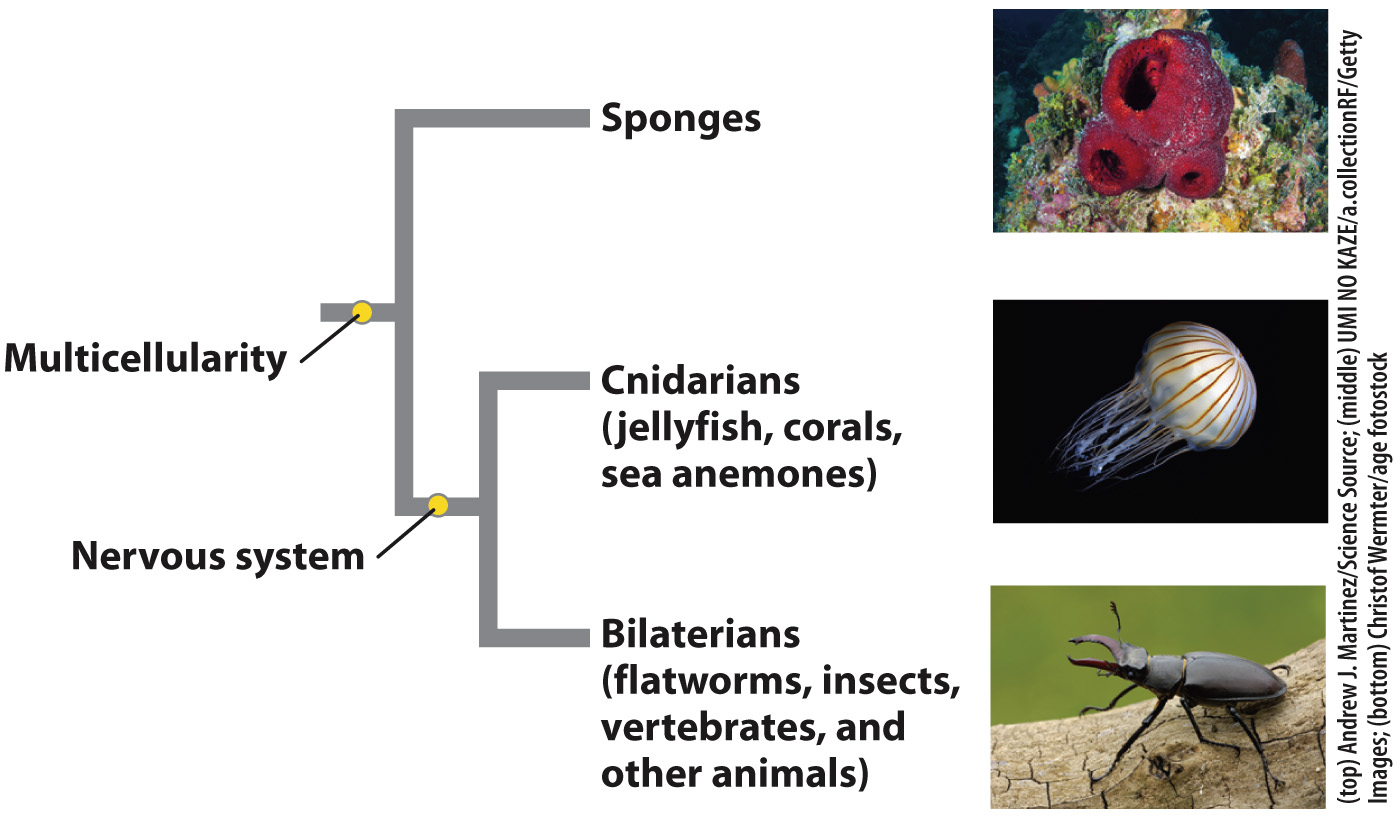Nervous systems range from simple to complex.
Even single-
Sponges are the only multicellular animals that lack a nervous system (Fig. 35.2). Sponges are marine animals that you may recognize from aquariums or photographs of coral reefs. They have tissues and organs, but lack any form of body symmetry. Many small pores along the side and a larger opening at the top draw nutrient-

Among multicellular organisms, the simplest nervous systems are found in cnidarians, which are radially symmetric animals such as jellyfish and sea anemones (Fig. 35.2). At one end of a cnidarian’s body is a mouth, surrounded by tentacles, that opens into a central body cavity where food is digested. The nervous system of these animals has relatively few neurons arranged like a net, but no ganglia or central brain (Fig. 35.3a). The nerve net of a sea anemone is organized around its body cavity. Sensory neurons sensitive to touch signal when one of the anemone’s tentacles has captured food prey, and then motor neurons react to coordinate the tentacle’s movement toward the mouth for feeding. Sensory neurons responding to a noxious stimulus signal the sea anemone to retract or detach from its substrate.

More complex nerve connections develop in the head end of flatworms, segmented annelid worms, insects, and cephalopod mollusks, such as squid and octopus. These animals are all bilaterians, animals like us with symmetrical right and left sides and a distinct front and back end (see Fig. 35.2; Chapter 44). Flatworms are representatives of one of the earliest branching groups of bilaterians, and their bodies are well adapted for forward locomotion. Flatworms are elongated, flattened organisms that glide along a streambed, trapping small animals under their bodies and sucking them in through a muscular opening in their underside. Sensory neurons are most numerous in the animal’s front end, so the flatworm can perceive the environment ahead of it as it moves forward. The flatworm’s nervous system can compare inputs from different sensory neurons and then send signals to the appropriate muscles to move toward a target. Paired ganglia (one on each side of the animal) in the head end of flatworms handle this processing task (Fig. 35.3b).
In animals with an organized nervous system, information is transmitted to different regions along the length of the animal’s body by distinct nerve cords and nerves. These are bundles of the long fiberlike extensions from multiple nerve cells.
In earthworms, paired ganglia, each made up of many interneurons, are located in each of the body’s segments (Fig. 35.3c). These segmental ganglia help to regulate the muscles within each body segment that move the earthworm’s body. Paired ganglia near the head regulate the activity of motor neurons that control movements of the mouth for feeding. Ganglia serve to regulate key processes in local regions and organs of the animal’s body. For example, local ganglia assist in processing information from the eyes (Chapter 36) or control the digestive state of an animal’s gut (Chapter 40). The homeostatic regulation of internal physiological processes is a fundamental role of nervous systems.
Centralized collections of neurons forming a brain are present in earthworms and other annelid worms (Fig. 35.3c), insects (Fig. 35.3d), and mollusks (Fig. 35.3e). Sense organs also developed in the head region, from eyespots in flatworms that respond to light to more sophisticated image-
In common with certain invertebrates, such as arthropods and cephalopod mollusks, the evolution of a brain is a key feature of vertebrate nervous systems (Fig. 35.3f). It enabled these organisms to evolve complex behaviors that rely on learning and memory and, in certain vertebrates, the ability to reason. At the same time, animal brains became increasingly complex in the number of nerve cells they contain (fruit fly, about 0.25 million; cockroach, about 1 million; mouse, about 75 million; humans, about 100 billion), in the number of connections between neurons, and in the variety of shapes and sizes of nerve cells and specialized connections between them.
Although animal nervous systems differ in organization and complexity, their nerve cells have fundamentally similar molecular and cellular features and use fundamentally the same mechanisms to communicate with neighboring cells. These mechanisms have been retained over the course of evolution to code and reliably transmit information. The ability to receive sensory information from the environment, and transmit and process this information within a nervous system, is therefore shared across a wide diversity of animal life, contributing to the success of multicellular animals.